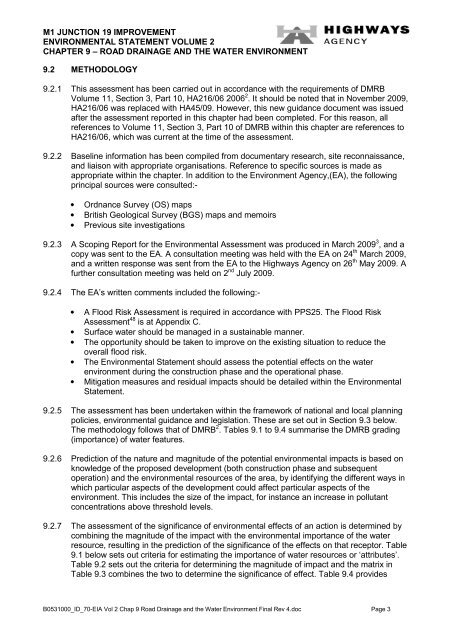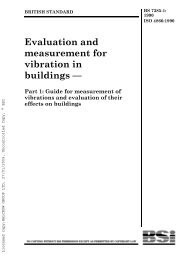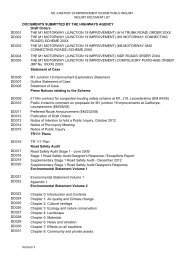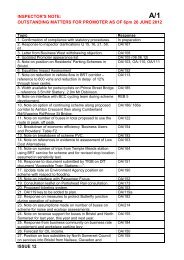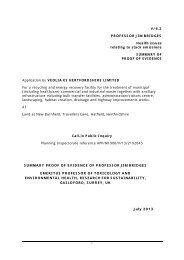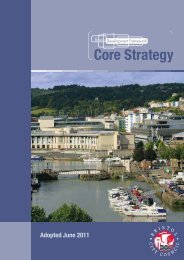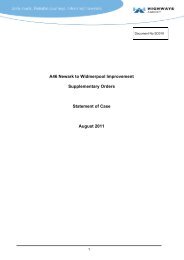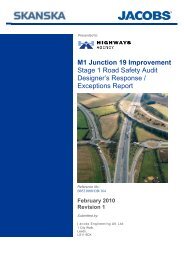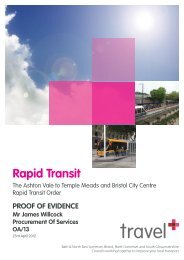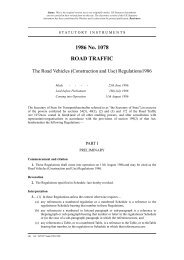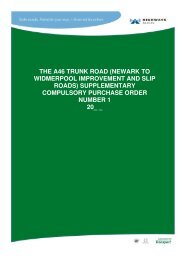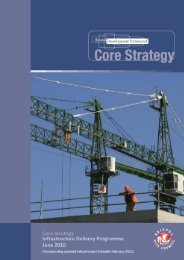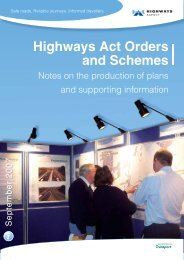Chapter 9: Road drainage and the water environment
Chapter 9: Road drainage and the water environment
Chapter 9: Road drainage and the water environment
Create successful ePaper yourself
Turn your PDF publications into a flip-book with our unique Google optimized e-Paper software.
M1 JUNCTION 19 IMPROVEMENT<br />
ENVIRONMENTAL STATEMENT VOLUME 2<br />
CHAPTER 9 – ROAD DRAINAGE AND THE WATER ENVIRONMENT<br />
9.2 METHODOLOGY<br />
9.2.1 This assessment has been carried out in accordance with <strong>the</strong> requirements of DMRB<br />
Volume 11, Section 3, Part 10, HA216/06 2006 2 . It should be noted that in November 2009,<br />
HA216/06 was replaced with HA45/09. However, this new guidance document was issued<br />
after <strong>the</strong> assessment reported in this chapter had been completed. For this reason, all<br />
references to Volume 11, Section 3, Part 10 of DMRB within this chapter are references to<br />
HA216/06, which was current at <strong>the</strong> time of <strong>the</strong> assessment.<br />
9.2.2 Baseline information has been compiled from documentary research, site reconnaissance,<br />
<strong>and</strong> liaison with appropriate organisations. Reference to specific sources is made as<br />
appropriate within <strong>the</strong> chapter. In addition to <strong>the</strong> Environment Agency,(EA), <strong>the</strong> following<br />
principal sources were consulted:-<br />
• Ordnance Survey (OS) maps<br />
• British Geological Survey (BGS) maps <strong>and</strong> memoirs<br />
• Previous site investigations<br />
9.2.3 A Scoping Report for <strong>the</strong> Environmental Assessment was produced in March 2009 3 , <strong>and</strong> a<br />
copy was sent to <strong>the</strong> EA. A consultation meeting was held with <strong>the</strong> EA on 24 th March 2009,<br />
<strong>and</strong> a written response was sent from <strong>the</strong> EA to <strong>the</strong> Highways Agency on 26 th May 2009. A<br />
fur<strong>the</strong>r consultation meeting was held on 2 nd July 2009.<br />
9.2.4 The EA’s written comments included <strong>the</strong> following:-<br />
• A Flood Risk Assessment is required in accordance with PPS25. The Flood Risk<br />
Assessment 48 is at Appendix C.<br />
• Surface <strong>water</strong> should be managed in a sustainable manner.<br />
• The opportunity should be taken to improve on <strong>the</strong> existing situation to reduce <strong>the</strong><br />
overall flood risk.<br />
• The Environmental Statement should assess <strong>the</strong> potential effects on <strong>the</strong> <strong>water</strong><br />
<strong>environment</strong> during <strong>the</strong> construction phase <strong>and</strong> <strong>the</strong> operational phase.<br />
• Mitigation measures <strong>and</strong> residual impacts should be detailed within <strong>the</strong> Environmental<br />
Statement.<br />
9.2.5 The assessment has been undertaken within <strong>the</strong> framework of national <strong>and</strong> local planning<br />
policies, <strong>environment</strong>al guidance <strong>and</strong> legislation. These are set out in Section 9.3 below.<br />
The methodology follows that of DMRB 2 . Tables 9.1 to 9.4 summarise <strong>the</strong> DMRB grading<br />
(importance) of <strong>water</strong> features.<br />
9.2.6 Prediction of <strong>the</strong> nature <strong>and</strong> magnitude of <strong>the</strong> potential <strong>environment</strong>al impacts is based on<br />
knowledge of <strong>the</strong> proposed development (both construction phase <strong>and</strong> subsequent<br />
operation) <strong>and</strong> <strong>the</strong> <strong>environment</strong>al resources of <strong>the</strong> area, by identifying <strong>the</strong> different ways in<br />
which particular aspects of <strong>the</strong> development could affect particular aspects of <strong>the</strong><br />
<strong>environment</strong>. This includes <strong>the</strong> size of <strong>the</strong> impact, for instance an increase in pollutant<br />
concentrations above threshold levels.<br />
9.2.7 The assessment of <strong>the</strong> significance of <strong>environment</strong>al effects of an action is determined by<br />
combining <strong>the</strong> magnitude of <strong>the</strong> impact with <strong>the</strong> <strong>environment</strong>al importance of <strong>the</strong> <strong>water</strong><br />
resource, resulting in <strong>the</strong> prediction of <strong>the</strong> significance of <strong>the</strong> effects on that receptor. Table<br />
9.1 below sets out criteria for estimating <strong>the</strong> importance of <strong>water</strong> resources or ‘attributes’.<br />
Table 9.2 sets out <strong>the</strong> criteria for determining <strong>the</strong> magnitude of impact <strong>and</strong> <strong>the</strong> matrix in<br />
Table 9.3 combines <strong>the</strong> two to determine <strong>the</strong> significance of effect. Table 9.4 provides<br />
B0531000_ID_70-EIA Vol 2 Chap 9 <strong>Road</strong> Drainage <strong>and</strong> <strong>the</strong> Water Environment Final Rev 4.doc Page 3


